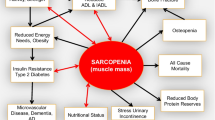Summary
-
1.
Guinea-pig ventricular small papillary muscles and trabeculae were rapidly frozen presystolically after prolonged rest following positive inotropic interventions which strongly influenced peak of force and time to peak force. The possible sources of activator calcium for the different types of contraction were investigated.
-
2.
After rest in the presence of noradrenaline (10−5mol/l) the first post-rest contraction showed a retarded activation and a “late” peak of force. Muscle strips frozen after a rest period of 5 min in a bath solution containing noradrenaline were cryosectioned and analyzed with X-ray microanalysis for elemental distribution: although at this time an applied stimulus would induce a potentiated contraction, intracellular membrane systems such as sarcoplasmic reticulum and mitochondria failed to reveal any accumulation of calcium.
-
3.
After rest in a low sodium Tyrode the first post-rest contraction showed an “early” peak of force. Muscles frozen after rest in a low sodium solution revealed intracellular Ca accumulation on the sarcoplasmic reticulum, in the network at the level of the Z-lines.
-
4.
The results support the hypothesis that 1. the sarcoplasmic reticulum (SR) accumulates calcium presystolically when “early” contractions follow stimulation; 2. the network of sarcoplasmic reticulum at the level of the Z-lines is a crucial source of activator calcium; 3. the activator calcium for late contractions is probably of extracellular origin.
Similar content being viewed by others
References
Allen DG, Jewell BR, Wood EH (1976) Studies of the contractility of mammalian myocardium at low rates of stimulation. J Physiol (London) 254:1–17
Antoni A, Jacob R, Kaufmann R (1969) Mechanische Reaktionen des Frosch- und Säugetiermyokards bei Veränderung der Aktionspotential-Dauer durch konstante Gleichstromimpulse. Pflügers Arch 306:33–57
Chapman RA (1979) Excitation-contraction coupling in cardiac muscle. Prog Biophys Mol Biol 35:1–52
Fabiato A (1983) Calcium-induced release of calcium from the cardiac sarcoplasmic reticulum. Am J Physiol 245 (Cell Physiol 14):C1-C14
Hall TA (1979) Biological X-ray microanalysis. J Microscopy 117:145–163
Jörgensen AO, Campbell KP (1984) Evidence for the presence of calsequestrin in two structurally different regions of myocardial sarcoplasmic reticulum. J Cell Biol 98:1597–1602
Koch-Weser J, Blinks JR (1963) The influence of the interval between beats on myocardial contractility. Pharmacol Rev 15:601–665
Lewartowsky B, Prokopczuk A, Pytowsky B (1978) Effect of inhibitors of slow calcium current on rested state contraction of papillary muscles and post rest contractions of atrial muscle of the cat and rabbit hearts. Pflügers Arch 377:167–175
Morad M, Goldman Y (1973) Excitation-contraction coupling in heart muscle: membrane control of development of tension. Prog Biophys Mol Biol 27:257–313
Reiter M, Vierling W, Seibel K (1984) Excitation-contraction coupling in rested state contractions of guinea-pig ventricular myocardium. Naunyn-Schmiedeberg's Arch Pharmacol 1:168–177
Sommer JR, Waughan RA (1976) The ultrastructure of the mammalian cardiac muscle cell with special emphasis on the tubular membrane system. Am J Path 82:192–221
Wendt-Gallitelli MF, Isenberg G (1985) Extra- and intracellular lanthanum: modified calcium distribution, inward currents and contractility in guinea-pig ventricular preparations. Pflügers Arch European J Physiol (in press)
Wendt-Gallitelli MF, Jacob R, Wolburg H (1982) Intracellular membranes as boundaries for ionic distribution. In situ elemental distribution in guinea-pig heart muscle in different defined electromechanical coupling states. Z Naturforsch 37c:712–720
Wendt-Gallitelli MF, Wolburg H (1984) Rapid freezing, cryosectioning, and X-ray microanalysis on cardiac muscle preparations in defined functional states. J Electron Microsc Technique 1:151–174
Wood EH, Heppner RL, Weidman S (1969) Inotropic effects of electric currents. Circ Res 24:409–445
Author information
Authors and Affiliations
Additional information
Dedicated to Prof. R. Jacob on the occasion of his 60th birthday
Supported by the Deutsche Forschungsgemeinschaft (grant We 879/3-1)
Rights and permissions
About this article
Cite this article
Wendt-Gallitelli, M.F. Presystolic calcium-loading of the sarcoplasmic reticulum influences time to peak force of contraction. X-ray microanalysis on rapidly frozen guinea-pig ventricular muscle preparations. Basic Res Cardiol 80, 617–625 (1985). https://doi.org/10.1007/BF01907860
Received:
Issue Date:
DOI: https://doi.org/10.1007/BF01907860




